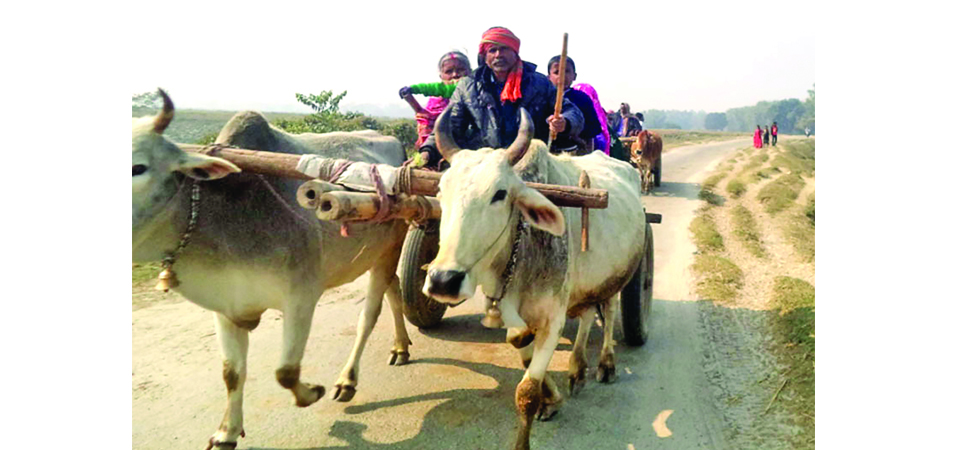Once common, bullock carts losing out to tractors, bikes

By Dhirendra Prasad Sah
Rajbiraj, Feb. 26: For centuries, bullock carts have symbolised the face of traditional village life, especially in the country’s Terai plains.
Despite the growth of motorised transportation, the bullock cart or Bayal Gadas continue to hold their own. Safe and reliable, these humble wooden carts with spoked wheels pulled by a couple of oxen or bulls serve as essential means for transporting goods and passengers.
Among the old timers, this archetypal rural transport holds a much more significant role than simply being a reliable companion for the road. As 80-year-old Sitabi Prasad Sah recounts, bullock carts used to be the quintessential requirement during wedding processions. “A procession comprised of a caravan of a dozen caparisoned bullock carts signified abundance, pride, and glory. The more the merrier,” reminisced Sah.
Unlike those days from the past, where each household in the village owned at least one bullock cart, today there are hardly a couple of them in an entire village, as per Sah.
Another fan of the Bayal Gada is a senior citizen, Ram Prasad Chaudhary. "Over-speeding is out of the question. So, there's no need to worry about accidents. Even in a rare case of an accident, the damage incurred is significantly minimal as compared to motor vehicles. It saves cost. No fuel consumption," said Chaudhary reflecting on the benefits of the said transportation.
"I have never heard of a single instance of someone getting killed in a Bayal Gada accident," added Karyahi Devi Khanga. The only concern, as Khanga puts it, was to reach a certain destination by sun down.
Apart from getting from point A to point B, the cart also enabled several households to earn their livelihood. According to elderly Kari Yadav, there used to be a dense forest to the east of Saptari's Rajbiraj. There were sparse settlements in and around the forest. "There weren't any markets nearby, so people had to cross the forest and then cover over 100 kilometres to reach the nearby Indian market of Nirmali Bazaar," he explained.
Back then, Yadav's grandfather earned his livelihood riding his bullock cart from the bazaar to the village, carrying both people and supplies, recalled Yadav.
In the wake of modernisation, though, the once ubiquitous means of transport is now rendered impractical. If two big bulky bulls covered the distances before, tractors and motorbikes have now penetrated the households serving the same purpose but much more efficiently. With tractors coming in handy to plough the fields, many villagers have stopped raising bulls, which, in return has contributed to a significant decline in bullock carts.
Hinging on the brink of extinction, the Bayal Gada, if not curated or preserved, might survive only in memories. To educate the next generation about such aspects of a bygone village lifestyle, it's important to store endangered household utilities in museums for future references.
Recent News

Do not make expressions casting dout on election: EC
14 Apr, 2022
CM Bhatta says may New Year 2079 BS inspire positive thinking
14 Apr, 2022
Three new cases, 44 recoveries in 24 hours
14 Apr, 2022
689 climbers of 84 teams so far acquire permits for climbing various peaks this spring season
14 Apr, 2022
How the rising cost of living crisis is impacting Nepal
14 Apr, 2022
US military confirms an interstellar meteor collided with Earth
14 Apr, 2022
Valneva Covid vaccine approved for use in UK
14 Apr, 2022
Chair Prachanda highlights need of unity among Maoist, Communist forces
14 Apr, 2022
Ranbir Kapoor and Alia Bhatt: Bollywood toasts star couple on wedding
14 Apr, 2022
President Bhandari confers decorations (Photo Feature)
14 Apr, 2022










